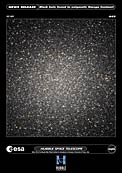The majestic globular Omega Centauri
A new discovery has resolved some of the mystery surrounding Omega Centauri, the largest and brightest globular cluster in the sky. Images obtained with the Advanced Camera for Surveys onboard the NASA/ESA Hubble Space Telescope and data obtained by the GMOS spectrograph on the Gemini South telescope in Chile show that Omega Centauri appears to harbour an elusive intermediate-mass black hole in its centre.
Credit:About the Image
NASA press release
| Id: | heic0809a |
| Type: | Observation |
| Release date: | 2 April 2008, 15:00 |
| Related releases: | heic0809 |
| Size: | 11936 x 10891 px |
About the Object
| Name: | NGC 5139, Omega Centauri |
| Type: | Milky Way : Star : Grouping : Cluster : Globular |
| Distance: | 17000 light years |
| Constellation: | Centaurus |
| Category: | Star Clusters |
Image Formats
Coordinates
| Position (RA): | 13 26 46.27 |
| Position (Dec): | -47° 28' 25.23" |
| Field of view: | 9.97 x 9.09 arcminutes |
| Orientation: | North is 6.0° left of vertical |
Colours & filters
| Band | Wavelength | Telescope |
|---|---|---|
| Optical B | 435 nm |
Hubble Space Telescope
ACS |
| Optical Pseudogreen (B+R) | ||
| Optical R | 625 nm | SDSS |



